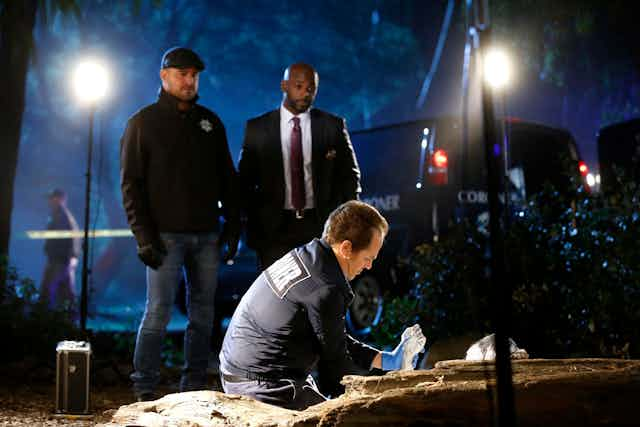After 15 years and several highly successful spin-offs the incredibly popular crime drama series CSI: Crime Scene Investigation is ending. And it’s doing so in style, with a two-hour special on September 27.
CSI and its franchise has achieved something unique: it has made forensics glamorous and sexy, viewing the dead while challenging beliefs that death is taboo. Turn on your TV and flick through the channels and you’re sure to come across corpses galore. CSI catalysed this process, encouraging public obsession with death and dying.
The show led the way for the portrayal of forensic science as entertainment to be embraced on a global scale. Early forensics shows such as Silent Witness or Quincy, M E didn’t have the same effect. CSI made forensics slick: it surrounded the dead bodies with creative professionals and technology. The key to justice, according to CSI, is to look at the dead using forensic science.
As a result of the original CSI series there has been a huge growth in portrayals of death and the dead in entertainment shows on television and in film. Seven of the top ten most-watched TV dramas are related to forensic science.
The dead have even been claimed to be “pop culture’s new star”. Nowhere is this more evident than in crime shows and films where there is regular acting work doing corpse duty. On set of forensics dramas live actors play dead, having to put up with actors pulling up their eyelashes or looking up their noses. Many fall asleep – literally sleeping like the dead.
So the boundaries between crime news and crime entertainment are being eroded by the CSI effect. Flicking between entertainment and news channels, the differences have become less and less. Public understanding of criminal justice, crime investigation and forensics is arguably rooted in the CSI effect. And as a result of this, public fascination with the dead is located primarily in sensational visually graphic images.
Forensic science
Corpses in forensic science dramas reflect the most extreme and dramatic deaths, ranging from fire to drowning to mummification and ritualised killings. One notable autopsy in Silent Witness showed the pathologist inspecting the body of a baby who had plastic packaging caught inside a post-operative wound. No form of death or corpse whether beautiful, ugly, old or young is beyond exposure as entertainment via forensics.
Such images feed public obsession with death and the macabre, and the range and number of corpses on fictional television shows suggests a desensitisation and normalisation process of viewing the dead. Often these are in an intimate state, such as during autopsies. Forensic science acts as a softening lens. It provides distance and protection from the realities of death and the dead whilst indulging fascination with the macabre.
And the rise of forensic science has been meteoric even beyond the entertainment sector. It has part of our cultural understanding of death, as reflected by The Wellcome Collection’s recent exhibition Forensics: the Anatomy of Crime. There has also been a massive growth in forensics university degree courses.

Reality hits
Of course this fascination with death doesn’t mean that we aren’t still shocked by real corpses. Forensic science and popular culture cushion us from reality. We are uncomfortable and disturbed by reality (take the controversy that the handling of bodies after the MH17 crash caused) whilst being entertained by realistic popular culture portrayals of similarly violent deaths.
So on one hand death is shocking. On the other it is a subject of fascination. The cultural sphere provides a safe and acceptable space where cadavers and death are normalised and can be viewed. But they are simultaneously celebrated, popularised and eroticised.
This is to be expected – entertainment has always provided a space where otherwise taboo subjects can be explored. But with the rise of citizen journalism, and the posting of visually consumable images of real death and corpses online, you have to question whether the line is becoming blurry at all, and how dangerous this is.
Exposure to death through autopsies in entertainment reflects the dangerous controversy of “autopsy porn”. Television has strict rules for how sex, nudity and violence are portrayed but this does not seem to apply to fiction where characters are both naked and dead. Pornography remains problematic on television but not via the autopsy.
Public obsession with the dead is being encouraged, and the softening lens of science is allowing death and the dead to be actively embraced in our everyday lives. CSI may be over, but the CSI effect has only just got going.

